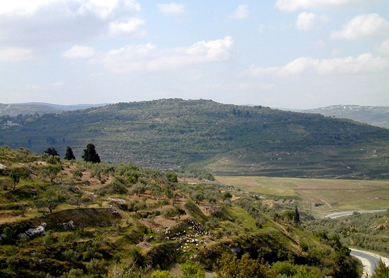The “land of Israel” is a biblical term for the small territory of the Near East between the Mediterranean coast and the Jordan Rift Valley. The land is also referred to as Palestine, the southern Levant, southern Syria, the holy land, the promised land, or the land of Canaan. In modern Hebrew, this geographic area can be referred to simply as ha-aretz, “the Land.” A key link in trade routes connecting Near Eastern and Mediterranean civilizations, the region has served as an important gateway between East and West. Its prominence in biblical thought as the traditional homeland of the Jews can obscure the fact that it has been home to a strikingly diverse array of cultures over time.
What geographical features are prominent in the land of Israel?
The land is marked by several geographical niches. Its fertile coastal plain and main transversal valley, the Jezreel, have supported wealthy urban economies in the past. Its highlands have tended to be less prosperous. They consist of Galilee in the north and the West Bank in the center, also known as Samaria and Judea. The central highlands were the traditional area of Israelite settlement in the Iron Age, with the more southerly Judean hills anchored by the city of Jerusalem. In the east is the deep depression called the Jordan Rift Valley, which contains the region’s two large bodies of water—the Sea of Galilee and the Dead Sea—and its main river, the Jordan. In the south are the Negev and Arabah Deserts and to the east are the Transjordanian highlands. The Judean Desert lies between the central highlands and the Dead Sea.
The earliest archaeological evidence of a people called Israel living in this territory comes from the central highlands in the Iron Age I (1200–1000 BCE). Their very name, Israel, can be translated “El fights for” and suggests a collective oriented around the worship of the Canaanite deity El. By the Iron Age II (1000–586 BCE), two Israelite kingdoms had formed in the highlands: the kingdom of Israel in the north and the kingdom of Judah in the south. The northern kingdom, with its capital at Samaria, would at points reach west to the Carmel coast, north beyond the Jezreel Valley and the Sea of Galilee, and east into Transjordan. The southern kingdom, with its capital at Jerusalem, was smaller and possibly always landlocked. Scholars debate whether the two kingdoms were initially united in the tenth century BCE by a royal house ruling from Jerusalem under David and Solomon, as told in the Deuteronomistic History (e.g.,
How does the Bible portray the connection between the people and the land of Israel?
The various books of the Hebrew Bible imagine settlement on this particular land as intrinsic to its people’s covenant with God. In
The boundaries of the land of Israel in priestly traditions, such as in
How have later traditions understood the importance of the land of Israel?
The theological importance of the land of Israel persisted in ancient Judaism, though by the late Second Temple period special emphasis was placed on the holiness of Jerusalem and its temple. The description of the holy war against the Greeks in 1 Maccabees, for example, focuses on the cleansing and rededication of the temple as the vital first step in the purification of the land. Efforts were made during this era to expand the borders of the land. For instance, the Hasmonean priest-kings, heirs to the Maccabees, expanded Judean territory southward into Idumea and northward into the heartland of the old kingdom of Israel, capturing Samaria, Jezreel, and Galilee in the late second century BCE. Herod would expand the kingdom of Judea further in the late first century BCE, adding substantial areas in the Transjordan and ruling over the largest territory ever governed by a Jewish regime in antiquity.
The total loss of that territory after the wars with Rome in the first and second centuries CE ushered in a new era of theological discourse on the land of Israel. The rabbis revitalized interest in the borders of the land by calling upon Jews to protect its sanctity through various religious customs. Many of these customs derive from biblical agricultural laws, such as tithing and the sabbatical, and are understood by the rabbis to be applicable only to those living within the land of Israel. Meanwhile, Christians revered the holy land because of its centrality to Old Testament stories and because it was where God was thought to have revealed himself to the world in human form. In the modern era, the Jewish return to the traditional land of Israel provided a means for national survival and self-determination in the face of European atrocities. Visions of a greater land of Israel, inspired by biblical writings, have characterized more radical expressions of Zionism, while belief in the possession of the central highlands as a Jewish birthright lives on in the Israeli settler movement. The concept of the land of Israel thus continues to play a central role in modern international politics.
Bibliography
- Wazana, Nili. All the Boundaries of the Land: The Promised Land in Biblical Thought in Light of the Ancient Near East. Winona Lake, IN: Eisenbrauns, 2013.
- Habel, Norman C. The Land Is Mine: Six Biblical Land Ideologies. Minneapolis: Fortress, 1995.
- Gordon, Benjamin D. Land and Temple: Field Sacralization and the Agrarian Priesthood of Second Temple Judaism. Berlin: de Gruyter, 2020.
- Safrai, Zeev E. Seeking Out the Land: Land of Israel Traditions in Ancient Jewish, Christian and Samaritan Literature (200 BCE–400 CE). Leiden: Brill, 2018.
- Davies, W. D. The Territorial Dimension of Judaism. Berkeley: University of California Press, 1982.





